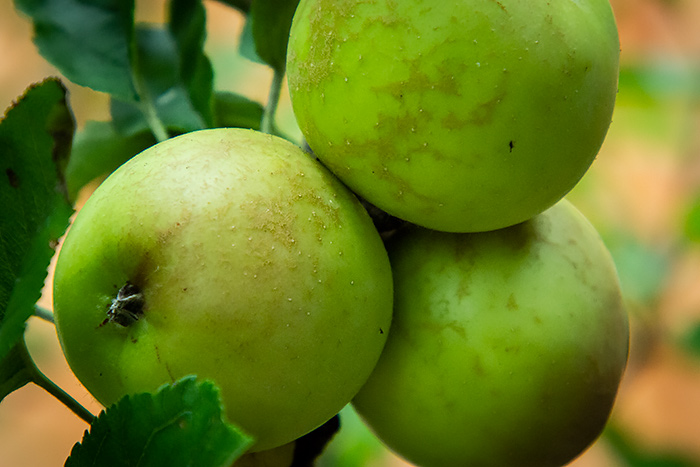Photo Corners headlinesarchivemikepasini.com
![]()
A S C R A P B O O K O F S O L U T I O N S F O R T H E P H O T O G R A P H E R
![]()
Enhancing the enjoyment of taking pictures with news that matters, features that entertain and images that delight. Published frequently.
Green Apples



7 September 2019
One of the fun things about producing Photo Corners (and fun is what keeps the productivity producing), is misdirection. Here we've titled this piece as if it were another artsy shot of the apples growing in our orchard. But it's really our first report on the Olympus M.Zuiko 12-200mm f3.4-6.3 zoom that arrived yesterday.

Green Apples. Captured on the Olympus E-Pl1 at f6.2, 1/160 second and ISO 640 using the M.Zuiko 12-200mm zoom at 94mm. Processed in Adobe Camera Raw.
Yesterday was a miserable day. Wet and foggy. We worked on our interactive editing project (not the Web version) under the warmth of a table lamp.
But we couldn't resist stepping outside for a few minutes with the new lens.
The thick little manual that comes with it is itself misleading. There are only two relevant pages. A diagram of the parts on one and the legend on the other. But you don't even need that because unlike the mysterious Olympus 12-100mm Pro we returned last week, there is no clutch or buttons on the lens itself.
It has just a narrow focusing ring in front and a big knurled zoom ring behind it. Even the lens hood is missing the locking button of the Pro, which in our opinion is an improvement.
Otherwise it's about the same size and weight as the 12-100mm Pro, so we expect to be able to walk around with it just as easily by holding the barrel of the lens.
The focal range provides a 35mm equivalent of 24mm to 400mm, which exceeds what we're accustomed to with our Nikkor 18-200mm zoom. If we ever get a sunset this summer, we'll be interested to frame it at 400mm.
But 400mm is a bit hard to hand hold. You watch the image bounce a bit in the viewfinder. And the 12-200mm zoom does not include image stabilization.
But there is image stabilization provided by the E-Pl1 body itself.
We have watched the suds in our beer flatten while the virtues of lens-based and body-based stabilization were being argued. For telephotos, if we recall, lens-based was "more effective" because, you know, a telephoto lens is longer and that's where the movement is. Or some such.
But the amber in the glass is that any stabilization is better than none and body based with a short telephoto works just fine.
When this lens was introduced in February, we were a bit skeptical that it was a good idea without image stabilization. Since we hadn't used the lens, we kept that skepticism to ourselves. But it was wrong headed.
The tradeoff is 100mm more (200mm equivalent) in reach for just body-based stabilization. A good trade.
Here is a combined chart of the two compact zooms:
OLYMPUS 12-200mm & 12-100mm PRO LENS SPECS COMPARISON M.Zuiko 12-200mm 12-100mm Pro Mount Micro Four Thirds Micro Four Thirds Focal Length 12mm to 200mm
(24-400mm equivalent)12mm to 100mm
(24-200mm equivalent)Aperture Maximum: f3.5 to f6.3
Minimum: f22
7 circular diaphragm bladesf4 to f22 throughout range
7 rounded diaphraghm bladesAngle of View 84° to 6.2° 84° to 12° Minimum Focus 8.64 inches 5.91 inches Magnification 0.1x to 0.23x 0.3x to 0.21x Optical Design 16 elements in 11 groups
3 aspherical, 2 Super ED, 2 ED, ! Super HR, 2 HR lenses17 elements in 11 groups
DSA lens, five ED lenses plus three aspherical, two Super HR and one HR lensAutofocus Yes Yes Image Stabilization None Yes Filter Thread 72mm 72mm Dimensions 3.05 x 3.92 inches 3.05 x 4.59-inches Weight 15.93 oz. 1.23 lb. Let us point out a few items of interest in the table above:
- Close focus at wide angle is 2.5 inches further away without a clutch on the 12-200mm zoom and magnification is about the same at telephoto. We have been surprised how close we can move in with this lens.
- The filter thread is the same size at 72mm, so we can use the same filters on both lenses (as well as our Nikkor).
- The Pro is half an inch longer (roughly) when retracted while the M.Zuiko is a quarter pound lighter.
We should also point out the M.Zuiko 12-200mm is $900 while the 20-100mm Pro is $1,150.
So there you have it. You thought you were getting an artsy piece on green apples and instead, for those intrepid souls who clicked through, you get a quick comparison between two Micro Four Thirds compact zooms.
As with apples, there's more to come.